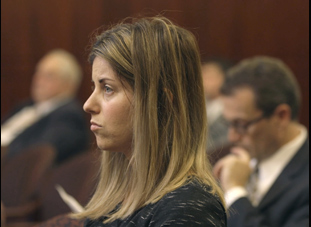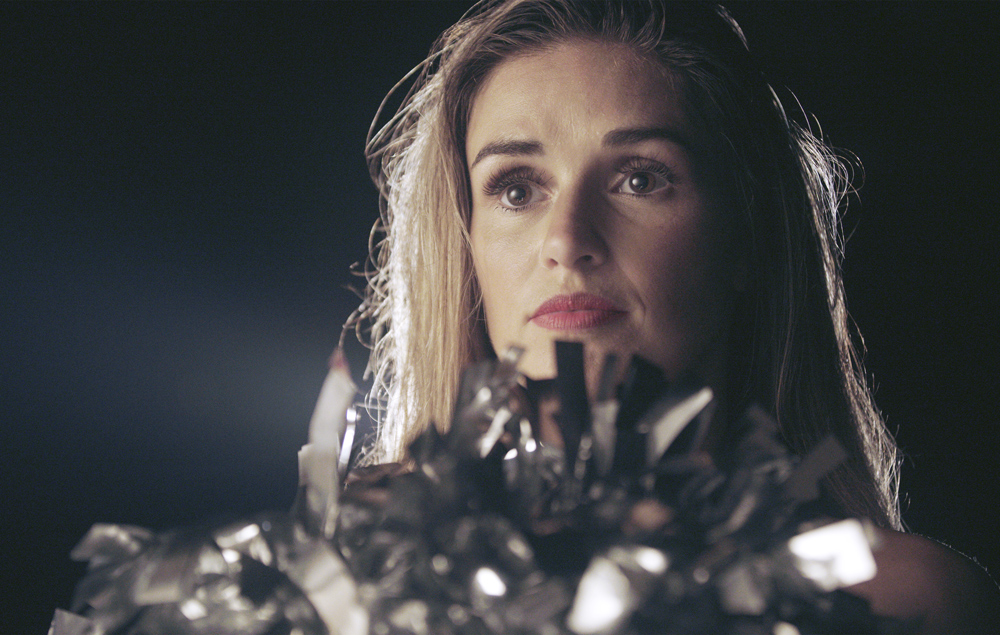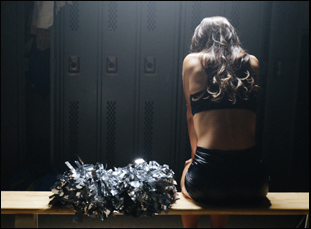“Game day is pretty much what you live for,” Lacy Thibodeaux-Fields can be heard saying at the start of “A Woman’s Work,” recounting her days as an Oakland Raiders cheerleader. This isn’t hyperbole when she says this — before donning the black and silver, she trained for years as a dancer good enough to even be considered for tryouts with the squad and put in thousands of hours a year into the practices leading up to any given Sunday. Yet Thibodeaux-Fields was unaware that she was part of a far larger game than just football, as director Yu Gu steps back to present in her illuminating second feature which looks at how the only area of the National Football League to primarily employ women doesn’t actually consider them as employees, but rather independent contractors who are unfairly compensated for the time they put into their jobs.
Gu collects testimony from Thibodeaux-Fields and others about how the cheerleaders put up their own cash for makeup to pose for calendars from which they never see any of the profits and attending events as the face of their respective team while they aren’t considered a part of the organization to the degree that they could receive benefits. In the process, she makes a compelling case for the NFL’s treatment of the cheerleaders as symptomatic of larger gender inequality issues in the U.S. where women still find themselves on the wrong end of the wage gap with their labor still not taken as seriously as men and expected to be satisfied with the opportunity to work at all. The film follows two lawsuits aiming to chip away at that disparity of opposite coasts, with Thibodeux-Fields filing one against the Raiders in California after being ostracized for speaking out and another in New York where Marie Pinzone sues the Buffalo Bills, who may dispatch their squad, the Jills, to various charity events in the community, yet show them little goodwill in return.
While the NFL does its best to distance itself from the cheerleaders, Gu outlines how close the connection really is as “America’s Game” reflects an economy increasingly relying on a freelance workforce and the considerable demands made on workers they seek to take no responsibility for in addition to the many issues of gender inequity raised and over the course of four years, the film shows the resolve of the women it profiles to change the status quo while also showing how adamant the powers that be are invested in keeping things the same as they have been since the 1960s when cheerleaders were first introduced into the NFL. During the Tribeca Film Festival where the film began a torrid festival run that continued this week at the L.A. Asian-Pacific Film Festival and will carry on into San Francisco this weekend at CAAMFest, Gu spoke about how a subject she didn’t expect to find interesting ultimately hit so close to home, overcoming the challenges of making a film about a league that holds the rights to its video material, and how the film found its moment as the #metoo movement gained steam.
It’s a little bit of an unlikely subject matter for me to tackle. I was born in China and then grew up in Canada, so I never watched football, but I went to USC for film school [during] the heyday of the Pete Carroll era. It was just overwhelming and I actually tutored football players in the school because I couldn’t work outside of the school, so I really got down and got into football culture — not just the game itself, but the culture surrounding it. It’s such a microcosm/allegory of America in general and American culture — the spirit of competition, the spectacle of capitalism, and this meritocracy and hierarchy, so I was just fascinated by the whole world of it.
Then in 2014, I read the first article about Lacey’s lawsuit that she alleged she was paid less than minimum wage to work for the National Football League as [one of] the only visible women on the field. That disillusioned me so much about the American dream in many ways. For me as an immigrant to this country and also from China, it’s something that I’m really passionate about because as an immigrant, I want to contribute to the society in a positive way that that will change it to reflect my values — the values of equality acceptance and all of those things. As a woman born in China under the one-child policy, I’ve always been aware of this gender inequality, whether it was in China or in my own family or in my daily life. So this story just spoke to me on all of those levels.
I got in touch with Lacy’s lawyers in Oakland and I met them and talk to Lacy for the first time, which I came in [not knowing] what to expect because I knew she was from a small town in Louisiana and had danced for the Golden State Warriors and the Oakland Raiders, so I thought this person I may or may not have anything in common with, but I found that it was really the opposite because we both grew up in these working-class families where our mothers juggled several jobs as well as taking care of the children and just worked inside the home and outside the home on in so many ways and we both understood the value of hard work and having to work for that dream, whether it’s filmmaking or dance, or cheering, so if we just connected immediately and that was when she said yes, I’ll be a part of this documentary, which I’m very grateful for and then it was from there, a lot of other lawsuits across country popped up. I brought on my producing partner Elizabeth [Ai] and then we went across country to meet all these different women.
How did Maria become the other anchor for the story?
We met Maria at the end of 2014 or early 2015, and Buffalo is just such an interesting place. It’s Rust Belt and very post-industrial — a lot of factories pulled out of that town, but it had this glorious industrial past, with in many ways a [strong] union past in terms of labor, but always characterized in a very masculine way. So I thought that was just a really great contrast with Oakland, California because these two women live on opposite coasts, but they’re sharing in many ways the same fight. I also thought Maria was very different from Lacy because Lacy knew she wanted to be a dancer and performer since she was very young, but for Maria, it was something else because Buffalo is such a small, tight-knit community and she really found a connection to that community through cheerleading and an ability to contribute to that community.
A lot of people don’t realize that a lot of the work that the cheerleaders do for the teams is they go out and represent the teams at different community events — children’s hospitals and breast cancer awareness, that put this positive face of the team out there. She really enjoyed that and she just wanted to be a part of something good as she says. And that was something unexpected because I think a lot of people think “Cheerleaders just want to look hot and dance,” but again this was an opportunity to look at a different side of women’s labor that you know doesn’t really get acknowledged or talked about because a lot of times women are the glue to a community, but their labor and their work is not recognized or valued as much as the husband that goes out and does a job, whatever that is. So I just felt like Lacy and Maria both connected with me also in very different ways and allowed me to compare and contrast their different stories, but also tie them together in a way that I thought was really interesting because they never meet and I like the idea there’s hundreds of thousands of women out there that I don’t know. But we are connected in a way because of our struggle, so I think that was really cool.
I’m sure you’re hearing all sorts of other awful stories related to cheerleading, likely involving sexual harassment and such, but this really keeps its focus business and labor-oriented. Was that obvious from the start?
Back in 2014, the lawsuits that did come up were more targeting wage theft, which I felt is a root issue that these women face, the fact that they are devalued in terms of their work and their bodies and their presence. It’s like a gateway to all of these other issues of harassment and gender discrimination, so I really did want to focus on that root issue. I also ended up talking to Bailey Davis of the New Orleans Saints about her claim of gender discrimination, which was also an extension of what I was exploring in terms of themes of the film, so it was really important to have that focus, but at the same time through Maria’s lawsuit [where it’s] alleged [there was] mistreatment at this golf tournament and the [cheerleaders] were forced to do certain things like sit on men’s laps and so on, it was a little bit of part of her experience, but I didn’t really want to explore that side of things through a lens of “they’re victims of this harassment.” There’s a section where she talks about the look of a cheerleader and the bold, sexy glamour of a cheerleader and how as a little girl she looked up to that and once it’s a specific thing you have to work toward, but once she did, she liked it. It was something that was fun for her to put herself into that role, but when you contrast that with other people’s internet comments, you see that devaluation and that dismissal, [where] you’re taking something so innocent — a young girl’s love of something that’s beautiful — but then others see that as something that’s dirty. And that is the inequality that we all live in.

Yes, it’s difficult, but we worked with Donaldson and Callif, which is a law firm based in Los Angeles. Our lawyer is Chris Perez and he was great in terms of talking to us about fair use, [which] I think is just so important for documentary filmmakers, especially independent filmmakers who are making films that are critical of certain institutions. We really focused on building this archival layer of the film using so many different sources, just being really smart and resourceful and finding stuff on the internet and from other films that we can use to evoke and visualize this world of football and this world of spectacle. And in terms of cheerleaders, from the beginning I knew I wanted to have this stylized component to it. I wouldn’t call it reenactment necessarily, but it’s more stylized and from a more subjective perspective of the cheerleaders as they’re out there dancing on the field and as they’re doing a job performing — [expressing] the love and this beauty of it that goes beyond what they’re marketed as by the teams and is more what the actual job feels like to them.
Specifically, I imagine it was interesting to build a sequence like the one involving the deposition of Stephanie Madison, the former owner of the Buffalo Jills where you primarily use text to illustrate.
Yeah, that was very difficult because we knew that deposition is were being done in Buffalo and there were thousands and thousands of pages of depositions of her and a bunch of executives from the Buffalo Bills including the president and unfortunately, there was no recording, so it didn’t exist in audio or video. It was just in the transcript form. So working with the editor, we wanted to make it a little bit like a graphics sequence using the words in graphic form and then comparing and contrasting the content of those words with the women fighting for women’s rights who are saying, “We have a sisterhood fighting for women’s rights and fighting for women’s worth” versus the content of the depositions, which was Stephanie Madison saying she was basically going along with everything that the Buffalo Bills and their management wanted her to do and resulted in the exploitation of these women instead of a positive contribution to women’s lives. I really love that sequence because it shows all the struggles that women have have experienced, but also how much further we have to go, not just in society but just women ourselves in terms of having the perspective of sisterhood – like what does that truly mean and how we going to come together for our own benefit and work in our own interests and not exploit each other and not devalue each other, so that was exciting.
Was there a point in this where you where you were thinking this movie might be about one thing and then it changed direction on you?
It hasn’t, which is weird because it has taken me so long to finish. It’s not long in terms of the grander scheme of documentary. It’s taken five years, but I feel like some of the things that I was curious about and that really drew me to the film ended up in the final version and you could see the continuation of that line of thinking or questioning, which is that in the beginning. I really wanted to get to know these women. I wanted to know what their dreams were, why they love what they love, what their fears are — all of those things I feel like in the four years that I’ve been following them, that has always been a guiding principle for me. And that’s something I feel like I have achieved in the final film. So the things I maybe didn’t expect were those outlying voices in the film, like DeMaurice Smith, the president of the NFL Players Union and also Lorena Gonzalez, who was also an assemblywoman. That was unexpected because I didn’t know there would be those side characters in the film, but they form this really interesting chorus and backdrop for [presenting] these women’s lives because they’re also really diverse. Lorena is the daughter of immigrants, and DeMaurice Smith and also the lawyers —you see how this issue of fighting for women’s work joins together all these vastly different people. That’s really inspiring and it also allows people to see beyond a very specific viewpoint. It opens things up in ways that I didn’t expect.
When did you know it was the right time to stop filming? It seems like the legal cases hit a number of standstills, so it might’ve been tempting to wrap earlier. [Spoilers ahead]
There were a lot of turning points I was not expecting. For example, when Lacey’s lawsuit was wrapping up in terms of mediation and then her moving to London, [where] I was like, “Wait, what? You’re moving to London?” I didn’t know if I was going to be documenting that leg of her journey. But because I wanted to focus on this bigger idea of women’s work, I decided to go to London and film with her as she’s realizing she wants more than being a housewife. She wants to get back into her passion of dance, so for her, I saw that as a resolution for her storyline. And for Maria, her lawsuit is still ongoing and that’s been a difficult process of filming the legal milestones of her case because there are so many different motions back and forth and the defendants are really drawing out this legal process by asking for more things, but they’re not really furthering the case or furthering the process, so her storyline, in many ways, was more difficult to find some kind of resolution for, but I want audiences to take that away from the film – this is not done yet.What’s it like to be putting this out into the world at this moment?
It’s very exciting because in 2014, this was before the election and before #metoo and in the press coverage of the initial lawsuits, people that were talking about misogyny and sexism, but it wasn’t in the same way. People didn’t necessarily believe it as much, so in pitching our film and talking about it, people were like “Hmm, yeah. Okay, so what?” And now I think it’s a perfect time for this film to get out into the world because more people are understanding the intersections of these issues that women face that are hampering our progress towards gender equality and the conversation has just opened up so much more. People are more bold to even talk about things like the patriarchal system, misogyny or the issues in the workplace and it’s not to say “This is men versus women,” but “We’re all in this together” and we should all think about the things we love and that we are loyal to, whether it’s football or movies or whatever else and what values are reflected in these systems.
“A Woman’s Work: The NFL’s Cheerleader Problem” airs on Independent Lens on January 4th at 10 pm on PBS and will stream thereafter on the PBS video app.





